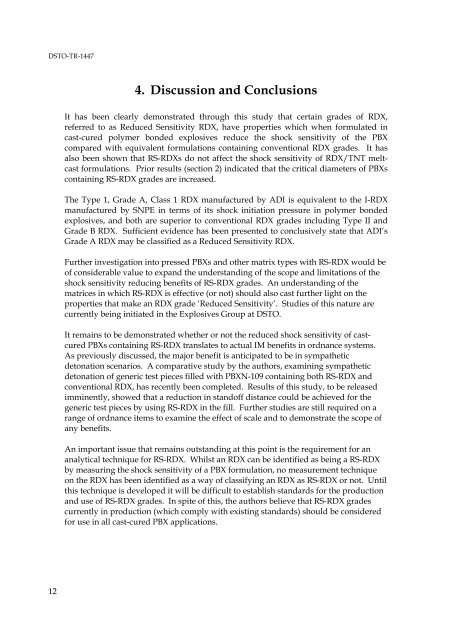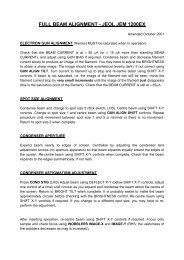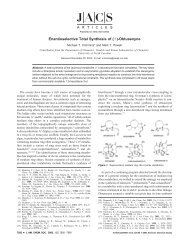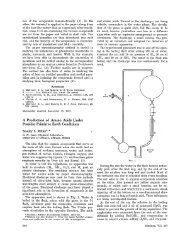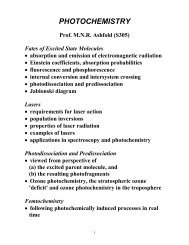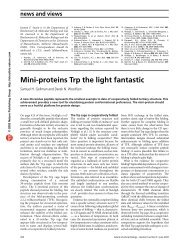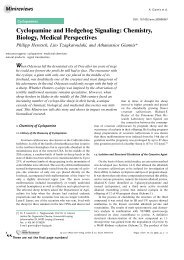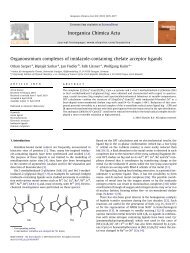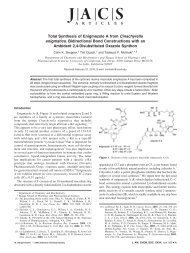Reduced Sensitivity RDX (RS-RDX) Part I: Literature Review and ...
Reduced Sensitivity RDX (RS-RDX) Part I: Literature Review and ...
Reduced Sensitivity RDX (RS-RDX) Part I: Literature Review and ...
You also want an ePaper? Increase the reach of your titles
YUMPU automatically turns print PDFs into web optimized ePapers that Google loves.
DSTO-TR-1447<br />
12<br />
4. Discussion <strong>and</strong> Conclusions<br />
It has been clearly demonstrated through this study that certain grades of <strong>RDX</strong>,<br />
referred to as <strong>Reduced</strong> <strong>Sensitivity</strong> <strong>RDX</strong>, have properties which when formulated in<br />
cast-cured polymer bonded explosives reduce the shock sensitivity of the PBX<br />
compared with equivalent formulations containing conventional <strong>RDX</strong> grades. It has<br />
also been shown that <strong>RS</strong>-<strong>RDX</strong>s do not affect the shock sensitivity of <strong>RDX</strong>/TNT meltcast<br />
formulations. Prior results (section 2) indicated that the critical diameters of PBXs<br />
containing <strong>RS</strong>-<strong>RDX</strong> grades are increased.<br />
The Type 1, Grade A, Class 1 <strong>RDX</strong> manufactured by ADI is equivalent to the I-<strong>RDX</strong><br />
manufactured by SNPE in terms of its shock initiation pressure in polymer bonded<br />
explosives, <strong>and</strong> both are superior to conventional <strong>RDX</strong> grades including Type II <strong>and</strong><br />
Grade B <strong>RDX</strong>. Sufficient evidence has been presented to conclusively state that ADI’s<br />
Grade A <strong>RDX</strong> may be classified as a <strong>Reduced</strong> <strong>Sensitivity</strong> <strong>RDX</strong>.<br />
Further investigation into pressed PBXs <strong>and</strong> other matrix types with <strong>RS</strong>-<strong>RDX</strong> would be<br />
of considerable value to exp<strong>and</strong> the underst<strong>and</strong>ing of the scope <strong>and</strong> limitations of the<br />
shock sensitivity reducing benefits of <strong>RS</strong>-<strong>RDX</strong> grades. An underst<strong>and</strong>ing of the<br />
matrices in which <strong>RS</strong>-<strong>RDX</strong> is effective (or not) should also cast further light on the<br />
properties that make an <strong>RDX</strong> grade ‘<strong>Reduced</strong> <strong>Sensitivity</strong>’. Studies of this nature are<br />
currently being initiated in the Explosives Group at DSTO.<br />
It remains to be demonstrated whether or not the reduced shock sensitivity of castcured<br />
PBXs containing <strong>RS</strong>-<strong>RDX</strong> translates to actual IM benefits in ordnance systems.<br />
As previously discussed, the major benefit is anticipated to be in sympathetic<br />
detonation scenarios. A comparative study by the authors, examining sympathetic<br />
detonation of generic test pieces filled with PBXN-109 containing both <strong>RS</strong>-<strong>RDX</strong> <strong>and</strong><br />
conventional <strong>RDX</strong>, has recently been completed. Results of this study, to be released<br />
imminently, showed that a reduction in st<strong>and</strong>off distance could be achieved for the<br />
generic test pieces by using <strong>RS</strong>-<strong>RDX</strong> in the fill. Further studies are still required on a<br />
range of ordnance items to examine the effect of scale <strong>and</strong> to demonstrate the scope of<br />
any benefits.<br />
An important issue that remains outst<strong>and</strong>ing at this point is the requirement for an<br />
analytical technique for <strong>RS</strong>-<strong>RDX</strong>. Whilst an <strong>RDX</strong> can be identified as being a <strong>RS</strong>-<strong>RDX</strong><br />
by measuring the shock sensitivity of a PBX formulation, no measurement technique<br />
on the <strong>RDX</strong> has been identified as a way of classifying an <strong>RDX</strong> as <strong>RS</strong>-<strong>RDX</strong> or not. Until<br />
this technique is developed it will be difficult to establish st<strong>and</strong>ards for the production<br />
<strong>and</strong> use of <strong>RS</strong>-<strong>RDX</strong> grades. In spite of this, the authors believe that <strong>RS</strong>-<strong>RDX</strong> grades<br />
currently in production (which comply with existing st<strong>and</strong>ards) should be considered<br />
for use in all cast-cured PBX applications.


